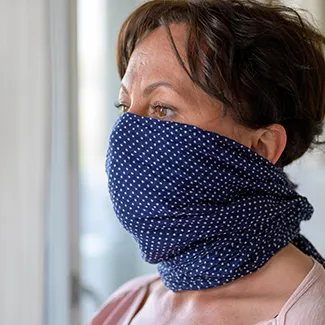May 01, 2020

Update October 16, 2020: Face coverings are now required for everyone both inside Denver Health facilities as well as outdoors, including on all Denver Health campuses/locations per Public Health order.
With the City and County of Denver and other Colorado communities issuing public health orders requiring (or soon to require) residents to wear masks or face-coverings when out in public to stop the spread of the novel coronavirus (COVID-19), we asked Denver Health Chief Medical Officer Connie Price, MD to explain how to select the right mask and the correct way to put it on and wear it.
Why It's Important to Wear Masks During COVID-19
The purpose of having everyone wear a mask is to protect others, in case you are sick or carrying the novel coronavirus (COVID-19). Tests have shown many people with COVID-19 are not symptomatic.
“You have to remember we’re trying to prevent transmission of these large respiratory droplets," Dr. Price told CBS Denver. "That’s how this is transmitted in normal settings."
Homemade or Store-Bought: How to Select the Best Mask for Coronavirus Protection
"Homemade masks and bandanas are perfectly reasonable for when we're outside of a health care setting," explained Dr. Price. "When I'm at home and I need to go to the grocery store, I wear a cotton bandana or similar cloth facial covering that you can wash."
We showed Dr. Price a surgical-type mask that we purchased at a local store that was labeled "KN95," a foreign version of the N95 masks that medical workers use in the United States. "KN95 usually means it filters 95 percent of particles you are inhaling," she said, adding she is highly suspicious that the mask we purchased was actually certified to be a KN95.
"The bottom line is, you don't need that level of filtration outside of a medical setting. Any cloth mask, a t-shirt or a bandana will protect you just fine."
Non-disposable masks should be washed after every use to avoid contamination, and wearers should wash their hands before putting it on and after taking it off.
Disposable masks – including those that look like medical masks, but are not actually validated for the medical setting – are acceptable to wear throughout the day as well, but Dr. Price said it is important to throw them out "when they are visibly soiled or wet or contaminated." These types of masks are not washable.
Dr. Price said that medical masks should not be worn out in public. "We really do want to preserve those for our front-line COVID-19 health care workers."
How to Put on and Wear Your Mask to Best Protect Against the Novel Coronavirus
There are four easy steps to putting on, wearing and removing a mask the right way for protection against the novel coronavirus. Before outlining those, Dr. Price said it's important to be careful not to contaminate your hands when you are putting on the mask, so be sure to wash your hands with either soap and water or waterless hand sanitizer.
- STEP 1: Grab the mask by the elastic straps or ends or head straps
- STEP 2: Place the mask over your face and carefully tuck it behind your ears or tie it behind your head, being careful not to touch the front part of the mask
- STEP 3: As you are wearing the mask, do not touch the front of the mask at all (if you need to make any adjustments, do it by touching the straps or cloth around your ears or on the side or back of your face, otherwise you risk either spreading contamination or contaminating yourself)
- STEP 4: When it's time to remove your mask, take it off by the edges or use the straps only, again being careful not to touch the front part
Reusable masks should be washed before the next use and disposable masks should be thrown away after one wear.
"I do want to emphasize that after taking your mask off, you must wash your hands with either soap and water or use the waterless hand sanitizer," Dr. Price stressed.
How to Store Your Face Mask to Protect Against the Novel Coronavirus
After your reusable mask has been washed, it's important to store it in a location where it will not get contaminated before the next time you have to wear it. Dr. Price advises using something that is breathable, like a paper bag. Masks can also be stored in areas where others won't touch it and risk contamination to themselves.
For the latest information about what is happening at Denver Health in response to the novel coronavirus (COVID-19), go to DenverHealth.org/coronavirus.

